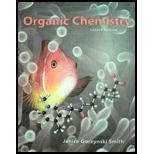
(a)
Interpretation: The curved arrows are to be drawn to show the conversion of C to D in Step [1].
Concept introduction: Curved arrows aid in determining the movement and flow of electrons in the reaction. The electrons that take part in the
(b)
Interpretation: The compound Y is to be identified by using the curved arrows drawn on compound D.
Concept introduction: Curved arrows aid in determining the movement and flow of electrons in the reaction. The electrons that take part in the chemical reactions are shown by the curved arrows. An electronegative element in the reaction attracts electron toward it.
Half headed arrows are used to show the flow of single electrons, while the full headed arrow shows the movement of electron pairs.
Want to see the full answer?
Check out a sample textbook solution
Chapter 6 Solutions
Organic Chemistry - With Access (Custom)
- . How many moles of O2 does each Co(salen) molecule absorb? (draw a structure of the oxygenated product). (b) Would N2, CO2, H2, or NO react with Co(salen)? Why?arrow_forwardDefine Radicals, Carbocations, and Carbanions ?arrow_forwardPlease draw the line structures for the C8H17+ carbocations that have the carbon skeleton below And please circle the most stable carbocationarrow_forward
- Draw an alkene and show its E and Z isomersarrow_forwardTrue or false Since the energy of the C-H bond is 416 kj/mol and the energy of the C=0rs bond is 678.5Kj/mol, it can be inferred that methanal is more reactive than methane.arrow_forwardComplete the reaction below. Circle and identify all the functional groups and linkages in reactants and products. Also identify the type of biochemical reactionarrow_forward
- PLEASE HELP ASAP.... The conversions must be completed in each step (A.) (B.) Carrow_forwardDraw an isomer of C5H10O that contains a ketonearrow_forward(a) Draw a skeletal structure of the anabolic steroid methenolone from the following description. Methenolone contains the tetracyclic steroid skeleton with a carbonyl group at C3, a hydroxyl at C17, a double bond between C1 and C2, and methyl groups bonded to C1, C10, and C13. (b) Add wedges and dashed wedges for all stereogenic centers with thefollowing information: the configuration at C10 is R, the configuration at C13 is S, the configuration at C17 is S, and all substituents at ring fusions are trans to each other. (c) Draw the structure of Primobolan, the product formed when methenolone is treated with CH3(CH2)5COCl and pyridine. Primobolan is an anabolic steroid that can be taken orally or by injection and has been used illegally by well-known Major League Baseball players.arrow_forward
- Consider the attached SN2 reaction. Question: a.) Draw a mechanism using curved arrows.b.) Draw an energy diagram. Label the axes, the reactants, products, Ea,and ΔH°. Assume that the reaction is exothermic.arrow_forwardMolecule A is a ?arrow_forwardDraw the curved arrow(s) to depict the formation of the keto form of an enolate ion via a strong base, B. Complete the resonance structures of the enolate anion\'s keto and enolate forms with bonds, charges, and nonbonding electron pairs. Use curved arrows to show how the keto form resonates to the enolate form.arrow_forward
 Organic Chemistry: A Guided InquiryChemistryISBN:9780618974122Author:Andrei StraumanisPublisher:Cengage Learning
Organic Chemistry: A Guided InquiryChemistryISBN:9780618974122Author:Andrei StraumanisPublisher:Cengage Learning Chemistry: Principles and ReactionsChemistryISBN:9781305079373Author:William L. Masterton, Cecile N. HurleyPublisher:Cengage Learning
Chemistry: Principles and ReactionsChemistryISBN:9781305079373Author:William L. Masterton, Cecile N. HurleyPublisher:Cengage Learning

